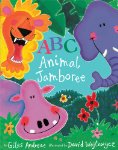Most of the ghosts that I have met in books have, at worst, been scary or even terrifying. They look and sound awful, but they cannot really do anything to you. The ghosts I met in today's book are altogether different. They belong in a category of their own, and I sincerely hope that they and their kind only exist within the pages of a book.
Cornelia Funke
Illustrated by Andrea Offermann
Translated by Oliver Latsch
Fiction
For ages 9 to 12
Little Brown, 2012, 978-0-316-05614-4
When Jon’s mother tells him that he is going to be sent
to a boarding school, Jon feels angry, upset, and betrayed. He blames his mother’s
new boyfriend, “The Beard,” for coming up with the plan, and when he arrives at
his new school in Salisbury, he is determined to be as miserable as possible.
This Jon manages to do with great success until something happens that quite
takes his mind of being sent to a boarding school.
On his sixth
night at the school, Jon looks out of his bedroom window and sees three
malevolent looking ghosts staring up at him. They are astride horses, and their
horrible appearance quite terrifies Jon. The next day, as he is walking back to
the school’s boardinghouse, he is pursued by four ghosts riding ghostly horses.
In terror, Jon runs from them, and when he explains his extraordinary behavior
to his teacher, everyone treats him as if he has gone mad.
Jon knows that no
one believes his story, so he pretends that he was just making it up. Only one
person doesn’t fall for this ploy. Ella, a very pretty girl who goes to Jon’s
school, believes that he has indeed seen four ghosts. Ella’s grandmother, who
fancies herself an expert on ghosts, does not believe that Jon is in danger
until she hears that his mother is a Hartgill. Apparently, two of Jon’s
ancestors, a father and son, were murdered by a man called Lord Stourton. The
lord was executed for his part in the murder, and ever since then male Hartgill
descendants have had nasty habit of dying unexpectedly.
Ella’s
grandmother suggests that Jon should go to another school, but Ella thinks that
he should ask for some help. In her opinion, Jon’s only hope is to ask the
ghost of William Longspee, the illegitimate half-brother of Richard the
Lionheart, for his help. Apparently the knight swore an oath that he would
“protect the innocent from the cruel, and the weak from the strong.” It is said
that he made this oath so that he could make up for the “sinful deeds” that he
did when he was alive.
Not knowing what
else to do, Jon asks William Longspee for his help, and to his amazement the
ghostly knight appears and promises to help Jon if he is threatened by Lord
Stourton and his four minions. Not long after this encounter with the knight,
Lord Stourton, his four servants, and two terrible hell hounds appear and
attack Jon and Ella. Jon calls for Longspee who comes to the boy’s aid and
dispenses with the dogs, the four ghostly servants, and their malevolent
master.
Jon is delighted
with Longspee’s success, and is so grateful and that he decides to do what he
can to free the knightly ghost from his oath so that he can finally have some
peace. Jon and Ella never imagine that their problems with Lord Stourton are
only just beginning.
Full of thrilling adventure, terrifying
ghostly doings, and surprising plot changes, this exceptional book will thrill
readers who have a fondness for ghost stories. It is not a tale for the faint
hearted, and throughout the story the author cleverly weaves fact and fiction
together to give readers a thoroughly captivating tale.




























